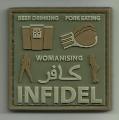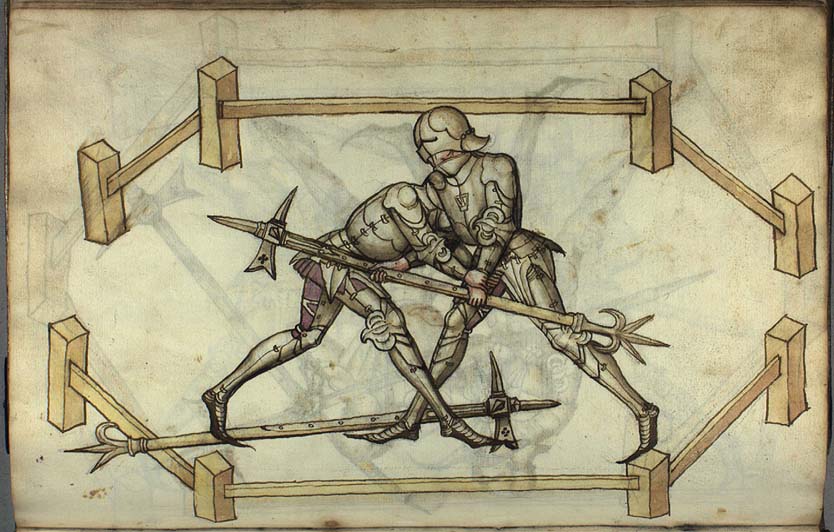| Author |
Message |
 |
|
|
 |
|
Advert
|
Forum adverts like this one are shown to any user who is not logged in. Join us by filling out a tiny 3 field form and you will get your own, free, dakka user account which gives a good range of benefits to you:
- No adverts like this in the forums anymore.
- Times and dates in your local timezone.
- Full tracking of what you have read so you can skip to your first unread post, easily see what has changed since you last logged in, and easily see what is new at a glance.
- Email notifications for threads you want to watch closely.
- Being a part of the oldest wargaming community on the net.
If you are already a member then feel free to login now. |
|
 |
![[Post New]](/s/i/i.gif) 2015/06/08 17:09:37
Subject: Halberds, flails, and other "Anti-Knight" technologies of the High Middle Ages
|
 |

Longtime Dakkanaut
|
The culmination of Medieval Warfare seems to be the Armored Heavy Cavalry, or Mounted Knight.
One can see the progression from the Sarmation Heavy Cavalry, to the Gothic, to the Carolingian/Frankish, to the Norman Milites, to the Medieval Knight.
Yet in this progression, there was an equal and opposite progression of arms intended to counter the Armored Warfare of the Middle Ages.
Infantry became denser, and armed with pikes, halberds, two-handed flails and spiked hammers, capable of easily punching through the heavy armor of a knight.
I will admit to being very poorly read in this period (La Morte D'Arthur being pretty much the most extensive period piece I have read that details medieval combat at all), being more affixed on the Dark Ages, prior to 1100AD.
So, what works are there that detail how these weapons were used against the Armored Knights of the Medieval Period?
How did they come to be deployed? Who used them? Where/when? Etc. . . .
MB
|
|
|
 |
 |
![[Post New]](/s/i/i.gif) 2015/06/08 19:59:24
Subject: Halberds, flails, and other "Anti-Knight" technologies of the High Middle Ages
|
 |

Highlord with a Blackstone Fortress
Adrift within the vortex of my imagination.
|
Big question, too much to comprehensively answer.
Armour moved from chain to plate progressively, requiring more penetration.
You penetrate either by puncturing or compressing plate armour, or passing trauma shock through it.
Plate is easier to damage than chain but absorbs more trauma.
Both require padding.
Later armours had heavy plate with thin padding, basically just a lining designed to deflect bullets, eventually the cuirass and helmet was all that remained.
|
n'oublie jamais - It appears I now have to highlight this again.
It is by tea alone I set my mind in motion. By the juice of the brew my thoughts aquire speed, my mind becomes strained, the strain becomes a warning. It is by tea alone I set my mind in motion. |
|
|
 |
 |
![[Post New]](/s/i/i.gif) 2015/06/08 20:17:27
Subject: Re:Halberds, flails, and other "Anti-Knight" technologies of the High Middle Ages
|
 |

Decrepit Dakkanaut
|
Well the pike was pretty much hand to a pheasa....eerrrr peasant. Not much training required. Swing, hook, punch, beat, chop, hack or wail on the guy in the armor can only go in one direction. Down 
|
Proud Member of the Infidels of OIF/OEF
No longer defending the US Military or US Gov't. Just going to ""**feed into your fears**"" with Duffel Blog 
Did not fight my way up on top the food chain to become a Vegan...
Warning: Stupid Allergy
Once you pull the pin, Mr. Grenade is no longer your friend
DE 6700
Harlequin 2500
RIP Muhammad Ali.
Jihadin, Scorched Earth 791. Leader of the Pork Eating Crusader. Alpha
|
|
|
 |
 |
![[Post New]](/s/i/i.gif) 2015/06/08 20:22:36
Subject: Re:Halberds, flails, and other "Anti-Knight" technologies of the High Middle Ages
|
 |

5th God of Chaos! (Yea'rly!)
The Great State of Texas
|
 Jihadin wrote: Jihadin wrote:Well the pike was pretty much hand to a pheasa....eerrrr peasant. Not much training required. Swing, hook, punch, beat, chop, hack or wail on the guy in the armor can only go in one direction. Down 
For ye Olde Goode People:
*Pikes
*halberds, bills and similar weaponry (spears etc with hooks and such that were better able to catch onto a rider)
*shiltrons (aka pikes but I separated them for...reasons)
For Ye OIde Yeomen
*long bows
For ye old Mercenaries
*crossbows
*hand and half swords/two handed swords as moved into later periods.
*hand cannon (and thus the first Texan was born) and not so hand cannon.
|
-"Wait a minute.....who is that Frazz is talking to in the gallery? Hmmm something is going on here.....Oh.... it seems there is some dispute over video taping of some sort......Frazz is really upset now..........wait a minute......whats he go there.......is it? Can it be?....Frazz has just unleashed his hidden weiner dog from his mini bag, while quoting shakespeares "Let slip the dogs the war!!" GG
-"Don't mind Frazzled. He's just Dakka's crazy old dude locked in the attic. He's harmless. Mostly."
-TBone the Magnificent 1999-2014, Long Live the King!
|
|
|
 |
 |
![[Post New]](/s/i/i.gif) 2015/06/08 20:40:59
Subject: Halberds, flails, and other "Anti-Knight" technologies of the High Middle Ages
|
 |

Decrepit Dakkanaut
|
BeAfraid wrote:
So, what works are there that detail how these weapons were used against the Armored Knights of the Medieval Period?
How did they come to be deployed? Who used them? Where/when? Etc. . . .
MB
I would suggest taking a look at Swiss Mercenaries, as well as Landsknecht soldiers.
Both of these are much later in time (as in around 1450-1580 or so). But each was feared and respected throughout Europe for their drill, tactics and equipment.
By the time of these guys, the Typical formation would look something like a phalanx: tight groups of squarish looking units. Front couple ranks of pike/halberd would be acting as a spikey wall to the front, while the sides would protect the flanks. The "dopplesoldner" would often have a dopplehander or bildenhander sword (more commonly called, and modernly named zweihander) sword, which was used for generally one or two purposes: First the sword would be used not against infantry, but against pikes to allow his own men to close with the other pikes. Secondly, he would often be partnered up with another veteran, and they'd use their swords to protect the banner. Somewhat tertiary to this (again, 14-1500s), was that these swords were pretty good against horses which would allow the infantry formation more success against mounted opposition.
|
|
|
 |
 |
![[Post New]](/s/i/i.gif) 2015/06/08 20:46:48
Subject: Halberds, flails, and other "Anti-Knight" technologies of the High Middle Ages
|
 |

Hangin' with Gork & Mork
|
I like my women like I like my phalanx: tight knit, forward facing, and armed with a shield.
Wait, that may not be right.
|
Amidst the mists and coldest frosts he thrusts his fists against the posts and still insists he sees the ghosts.
|
|
|
 |
 |
![[Post New]](/s/i/i.gif) 2015/06/08 20:53:19
Subject: Halberds, flails, and other "Anti-Knight" technologies of the High Middle Ages
|
 |

5th God of Chaos! (Yea'rly!)
The Great State of Texas
|
|
-"Wait a minute.....who is that Frazz is talking to in the gallery? Hmmm something is going on here.....Oh.... it seems there is some dispute over video taping of some sort......Frazz is really upset now..........wait a minute......whats he go there.......is it? Can it be?....Frazz has just unleashed his hidden weiner dog from his mini bag, while quoting shakespeares "Let slip the dogs the war!!" GG
-"Don't mind Frazzled. He's just Dakka's crazy old dude locked in the attic. He's harmless. Mostly."
-TBone the Magnificent 1999-2014, Long Live the King!
|
|
|
 |
 |
![[Post New]](/s/i/i.gif) 2015/06/08 20:56:12
Subject: Halberds, flails, and other "Anti-Knight" technologies of the High Middle Ages
|
 |

Ancient Venerable Dark Angels Dreadnought
|
Flails weren't used as anti-knight weapons by anyone other than Knights, and even then flails were incredibly rare. Almost all examples of them are from artwork (which is incredibly unreliable), and the physical examples are often Victorian reproductions.
Also, halberds, pikes, etc aren't the truly effective weapons. The one thing you'd want above all other weapons when fighting a knight is a poleaxe or crow's beak. They're capable of punching clean through plate armor with heavy strikes, spiking him much like using a pick to kill a crab.
So for single combat when fighting heavy infantry, a footman would want something like a shorter crow's beak or poleaxe so it can't be bashed aside for the charge. But on the battlefield in formations, pike blocks are scary. It's typically a giant spikey square of angry Germans or Swiss that have received some of the best training of the time and will almost never break formation.
|
“There is only one good, knowledge, and one evil, ignorance.”
|
|
|
 |
 |
![[Post New]](/s/i/i.gif) 2015/06/08 21:09:32
Subject: Halberds, flails, and other "Anti-Knight" technologies of the High Middle Ages
|
 |

Heroic Senior Officer
|
The best thing in warfare is having soldiers that don't scatter.
The horses will not charge you if they can't go through you. They either stop running, run around your unit, or the cavalry will break off the charge. Of course this gets problematic when cannon start being introduced and cavalry could force infantry into juicy targets.
Now it's is easy to say "just stand still and the horse can;t get you" but imagine seeing enemy horse slowly build up the charge coming straight at you. Your first instinct is to move out of the way. It takes lots of practice, experience or willpower to stay and not scatter in the face of cavalry.
So hooks, spears and pikes tended to be the best as it allowed troops who kept their nerve to retain a deadly formation against anything with less willpower than they had.
Ranged weapons complicate this further though, but it is unclear just how archers actually were used in battle. I have seen huge debates over how archers from any time period were actually deployed and used. But we do know that they had a vital role in more than likely harassing and trying to break enemy formations up for a rout.
I am unsure of how many weapons outside of polearms and long swords could actually be useful in a melee. When formations are fighting you don't have space to swing etc. More than likely you will have to be stabbing, or in the case of the horse lancing/slicing (if the enemy scatter). How does one use a flail when you have a people shoulder to shoulder? Even things like hammers or maces would be problematic. Hence why spears, pikes and the like tend to be common. They also happen to be cheaper and easier to use.
I don't have a lot of knowledge though on this period.
|
|
|
 |
 |
![[Post New]](/s/i/i.gif) 2015/06/08 21:16:40
Subject: Re:Halberds, flails, and other "Anti-Knight" technologies of the High Middle Ages
|
 |

Highlord with a Blackstone Fortress
Adrift within the vortex of my imagination.
|
 Jihadin wrote: Jihadin wrote:Well the pike was pretty much hand to a pheasa....eerrrr peasant. Not much training required. Swing, hook, punch, beat, chop, hack or wail on the guy in the armor can only go in one direction. Down 
Nooooo.
Stick to your assault rifles Jihadin.
The pike is not a peasant weapon, the spear is a medieval peasant weapon. The pike requires a lot of drill. In the hands of veteran troops it is lethal, in undisciplined hands its a death sentence.
From your description you are describing polearms though. Halberds are not peasant weapons either, they cost a bit, but a cheap cut down halberd, a glaive or bill is good for levy troops. The Frenchies liked the glaive, the English the bill both were effective. The Scots liked the pike, but never learned the lessons of pike combat and wer prey to English bill formations. This was because the Scottish elite were well educated, but got their education elsewhere in Europe, in university cities which had an educated populace and thus well trained citizen pike militia. They brought the knowledge home and realised only too late it didn't match the skills and mindset of the Scottish commoner.
|
n'oublie jamais - It appears I now have to highlight this again.
It is by tea alone I set my mind in motion. By the juice of the brew my thoughts aquire speed, my mind becomes strained, the strain becomes a warning. It is by tea alone I set my mind in motion. |
|
|
 |
 |
![[Post New]](/s/i/i.gif) 2015/06/08 21:18:45
Subject: Halberds, flails, and other "Anti-Knight" technologies of the High Middle Ages
|
 |

Master Tormentor
|
 Ahtman wrote: Ahtman wrote:I like my women like I like my phalanx: tight knit, forward facing, and armed with a shield.
Wait, that may not be right.
Brutally efficient and with a massive spear? 
|
|
|
 |
 |
![[Post New]](/s/i/i.gif) 2015/06/08 21:18:58
Subject: Re:Halberds, flails, and other "Anti-Knight" technologies of the High Middle Ages
|
 |

5th God of Chaos! (Yea'rly!)
The Great State of Texas
|
They brought the knowledge home and realised only too late it didn't match the skills and mindset of the Scottish commoner.
Except it worked really damn well for Robert the Bruce. . . Mmm just imagine the French at Crecy vs....the Comanche Empire...so much dakka so little escargo. Sorry did I drift off again.
|
|
This message was edited 1 time. Last update was at 2015/06/08 21:20:37
-"Wait a minute.....who is that Frazz is talking to in the gallery? Hmmm something is going on here.....Oh.... it seems there is some dispute over video taping of some sort......Frazz is really upset now..........wait a minute......whats he go there.......is it? Can it be?....Frazz has just unleashed his hidden weiner dog from his mini bag, while quoting shakespeares "Let slip the dogs the war!!" GG
-"Don't mind Frazzled. He's just Dakka's crazy old dude locked in the attic. He's harmless. Mostly."
-TBone the Magnificent 1999-2014, Long Live the King!
|
|
|
 |
 |
![[Post New]](/s/i/i.gif) 2015/06/08 21:20:43
Subject: Halberds, flails, and other "Anti-Knight" technologies of the High Middle Ages
|
 |

Pragmatic Primus Commanding Cult Forces
|
 Wyzilla wrote: Wyzilla wrote:Flails weren't used as anti-knight weapons by anyone other than Knights, and even then flails were incredibly rare. Almost all examples of them are from artwork (which is incredibly unreliable), and the physical examples are often Victorian reproductions.
Also, halberds, pikes, etc aren't the truly effective weapons. The one thing you'd want above all other weapons when fighting a knight is a poleaxe or crow's beak. They're capable of punching clean through plate armor with heavy strikes, spiking him much like using a pick to kill a crab.
So for single combat when fighting heavy infantry, a footman would want something like a shorter crow's beak or poleaxe so it can't be bashed aside for the charge. But on the battlefield in formations, pike blocks are scary. It's typically a giant spikey square of angry Germans or Swiss that have received some of the best training of the time and will almost never break formation.
Actually, flails were mostly used by farmers in peasant rebellions. Being farming equipment, they were easily available and one of the few weapons farmers had effective against armour.
|
Error 404: Interesting signature not found
     |
|
|
 |
 |
![[Post New]](/s/i/i.gif) 2015/06/08 21:29:04
Subject: Re:Halberds, flails, and other "Anti-Knight" technologies of the High Middle Ages
|
 |

Highlord with a Blackstone Fortress
Adrift within the vortex of my imagination.
|
 Frazzled wrote: Frazzled wrote:
For ye Olde Goode People:
*Pikes
*halberds, bills and similar weaponry (spears etc with hooks and such that were better able to catch onto a rider)
*shiltrons (aka pikes but I separated them for...reasons)
Frazzie thou art a sausage dogge packing pimperknickle, and only have it halfe right.
Goode people of goode name might pertake of pikes and halberds if part of the citizen militia of a wealthy town, or livery troops of a gentil lord.
The common goodefolk would bear the bill or heavy mace. Cheaper levy troops would take only the spear.
It taketh fething decades to learn to use the longbow properly. Only nations with a good report betwee gentil and commoner could afford yeomen so trained. So this meant the English and Welsh.
Peasant yeomen elsewhere and most of the rest of the English tended to use the shortbow, or again the spear or bill. Though none wanted to hirest English shortbowmen allowing for whatt else wast of offer.
 Frazzled wrote: Frazzled wrote:
For ye old Mercenaries
*crossbows
*hand and half swords/two handed swords as moved into later periods.
*hand cannon (and thus the first Texan was born) and not so hand cannon.
Frazzie gotte this mostly right. Mercenaries favoured missile weapons or formations of heavy armoured infantrie and cavalrie. The tricke was nott to die, so you carried a crossbow, or if you coulde join a badass unit of heavy infantry noone but a wolfshead wanted to messe with.
Remember dopplersoldners get double pay, thou gettes double pay by carrying a greatsword and going in first to break up the enemy spear formation, which is what they were good at. Thou shouldst withdraw once that is done, and let the common presse of spear win the battle. Automatically Appended Next Post:  Frazzled wrote: Frazzled wrote: They brought the knowledge home and realised only too late it didn't match the skills and mindset of the Scottish commoner.
Except it worked really damn well for Robert the Bruce. . .
Scots used the shiltron at the time, but IIRC the pike came in later.
Also a superior army doesn't mean much if your commander (and king) is a complete scumbag.
|
|
This message was edited 1 time. Last update was at 2015/06/08 21:30:53
n'oublie jamais - It appears I now have to highlight this again.
It is by tea alone I set my mind in motion. By the juice of the brew my thoughts aquire speed, my mind becomes strained, the strain becomes a warning. It is by tea alone I set my mind in motion. |
|
|
 |
 |
![[Post New]](/s/i/i.gif) 2015/06/08 21:33:08
Subject: Halberds, flails, and other "Anti-Knight" technologies of the High Middle Ages
|
 |

Decrepit Dakkanaut
|
 Iron_Captain wrote: Iron_Captain wrote: Wyzilla wrote: Wyzilla wrote:Flails weren't used as anti-knight weapons by anyone other than Knights, and even then flails were incredibly rare. Almost all examples of them are from artwork (which is incredibly unreliable), and the physical examples are often Victorian reproductions.
Also, halberds, pikes, etc aren't the truly effective weapons. The one thing you'd want above all other weapons when fighting a knight is a poleaxe or crow's beak. They're capable of punching clean through plate armor with heavy strikes, spiking him much like using a pick to kill a crab.
So for single combat when fighting heavy infantry, a footman would want something like a shorter crow's beak or poleaxe so it can't be bashed aside for the charge. But on the battlefield in formations, pike blocks are scary. It's typically a giant spikey square of angry Germans or Swiss that have received some of the best training of the time and will almost never break formation.
Actually, flails were mostly used by farmers in peasant rebellions. Being farming equipment, they were easily available and one of the few weapons farmers had effective against armour.
I believe he was referring to actual weaponised or purpose-made fighting flails, as opposed to the agricultural ones used in a pinch. The latter were common, but the former not nearly so.
|
Mandorallen turned back toward the insolently sneering baron. 'My Lord,' The great knight said distantly, 'I find thy face apelike and thy form misshapen. Thy beard, moreover, is an offence against decency, resembling more closely the scabrous fur which doth decorate the hinder portion of a mongrel dog than a proper adornment for a human face. Is it possibly that thy mother, seized by some wild lechery, did dally at some time past with a randy goat?' - Mimbrate Knight Protector Mandorallen.
Excerpt from "Seeress of Kell", Book Five of The Malloreon series by David Eddings.
My deviantART Profile - Pay No Attention To The Man Behind The Madness
"You need not fear us, unless you are a dark heart, a vile one who preys on the innocent; I promise, you can’t hide forever in the empty darkness, for we will hunt you down like the animals you are, and pull you into the very bowels of hell." Iron - Within Temptation |
|
|
 |
 |
![[Post New]](/s/i/i.gif) 2015/06/08 21:35:15
Subject: Halberds, flails, and other "Anti-Knight" technologies of the High Middle Ages
|
 |

5th God of Chaos! (Yea'rly!)
The Great State of Texas
|
I will yield on the bows, although I was thinking longbowmen for Yeoman.
Spears, yes for da peasants. Again, I'm thinking more later period English. I don't know what the French really had because...Errol Flynn wasn't French.
I think we need to revisit this what if of the Comanches vs. the French. Alternatively Quanah Parker vs. Richard the Lionheart on this week's Ultimate Warrior!
|
-"Wait a minute.....who is that Frazz is talking to in the gallery? Hmmm something is going on here.....Oh.... it seems there is some dispute over video taping of some sort......Frazz is really upset now..........wait a minute......whats he go there.......is it? Can it be?....Frazz has just unleashed his hidden weiner dog from his mini bag, while quoting shakespeares "Let slip the dogs the war!!" GG
-"Don't mind Frazzled. He's just Dakka's crazy old dude locked in the attic. He's harmless. Mostly."
-TBone the Magnificent 1999-2014, Long Live the King!
|
|
|
 |
 |
![[Post New]](/s/i/i.gif) 2015/06/08 22:03:04
Subject: Halberds, flails, and other "Anti-Knight" technologies of the High Middle Ages
|
 |

Decrepit Dakkanaut
|
 Avatar 720 wrote: Avatar 720 wrote: Iron_Captain wrote: Iron_Captain wrote: Wyzilla wrote: Wyzilla wrote:Flails weren't used as anti-knight weapons by anyone other than Knights, and even then flails were incredibly rare. Almost all examples of them are from artwork (which is incredibly unreliable), and the physical examples are often Victorian reproductions.
Also, halberds, pikes, etc aren't the truly effective weapons. The one thing you'd want above all other weapons when fighting a knight is a poleaxe or crow's beak. They're capable of punching clean through plate armor with heavy strikes, spiking him much like using a pick to kill a crab.
So for single combat when fighting heavy infantry, a footman would want something like a shorter crow's beak or poleaxe so it can't be bashed aside for the charge. But on the battlefield in formations, pike blocks are scary. It's typically a giant spikey square of angry Germans or Swiss that have received some of the best training of the time and will almost never break formation.
Actually, flails were mostly used by farmers in peasant rebellions. Being farming equipment, they were easily available and one of the few weapons farmers had effective against armour.
I believe he was referring to actual weaponised or purpose-made fighting flails, as opposed to the agricultural ones used in a pinch. The latter were common, but the former not nearly so.
Yeah, I was gonna say. A farmers flail would be made entirely of wood and pretty ineffective against plate armor. A military flail is a completely different matter.
|
|
|
 |
 |
![[Post New]](/s/i/i.gif) 2015/06/08 22:37:49
Subject: Halberds, flails, and other "Anti-Knight" technologies of the High Middle Ages
|
 |

Decrepit Dakkanaut
|
Swastakowey wrote:
The horses will not charge you if they can't go through you.
Do you have a source for this?? I ask because everything that I have read suggests otherwise, when talking specifically about destriers or other "warhorses" that were bred and trained for fighting.
Wyzilla wrote:
Also, halberds, pikes, etc aren't the truly effective weapons. The one thing you'd want above all other weapons when fighting a knight is a poleaxe or crow's beak. They're capable of punching clean through plate armor with heavy strikes, spiking him much like using a pick to kill a crab.
A halberd is a type of poleaxe... the only real difference between the two: the halberd has a "spear tip" on the top of it, whereas the poleaxe is exactly as it sounds: an ax on top of a pole.
|
|
|
 |
 |
![[Post New]](/s/i/i.gif) 2015/06/08 23:19:15
Subject: Halberds, flails, and other "Anti-Knight" technologies of the High Middle Ages
|
 |

Heroic Senior Officer
|
 Ensis Ferrae wrote: Ensis Ferrae wrote:Swastakowey wrote:
The horses will not charge you if they can't go through you.
Do you have a source for this?? I ask because everything that I have read suggests otherwise, when talking specifically about destriers or other "warhorses" that were bred and trained for fighting.
No time for indepth at work, but it is common knowledge for cavalry. Wikipedia has a blurb on it The shock value of a charge attack has been especially exploited in cavalry tactics, both of armored knights and lighter mounted troops of both earlier and later eras. Historians such as John Keegan have shown that when correctly prepared against (such as by improvising fortifications) and, especially, by standing firm in face of the onslaught, cavalry charges often failed against infantry, with horses refusing to gallop into the dense mass of enemies,[4] or the charging unit itself breaking up. However, when cavalry charges succeeded, it was usually due to the defending formation breaking up (often in fear) and scattering, to be hunted down by the enemy.[5] It must be noted, though, that while it was not recommended for a cavalry charge to continue against unbroken infantry, charges were still a viable danger to heavy infantry. Parthian lancers were noted to require significantly dense formations of Roman legionaries to stop, and Frankish knights were reported to be even harder to stop, if the writing of Anna Comnena is to be believed. However, Keegan's assessment is, in the most part, correct; only highly trained horses would voluntarily charge dense, unbroken enemy formations directly, and in order to be effective, a strong formation would have to be kept - such strong formations being the result of efficient training. Heavy cavalry lacking even a single part of this combination - composed of high morale, excellent training, quality equipment, individual prowess, and collective discipline of both the warrior and the mount - would suffer in a charge against unbroken heavy infantry, and only the very best heavy cavalrymen (e.g. knights, cataphracts) throughout history would own these in regards to their era and terrain.
I think the blurb is very generous to the cavalry against infantry however.
|
|
This message was edited 1 time. Last update was at 2015/06/08 23:37:15
|
|
|
 |
 |
![[Post New]](/s/i/i.gif) 2015/06/08 23:38:08
Subject: Halberds, flails, and other "Anti-Knight" technologies of the High Middle Ages
|
 |

The Conquerer
Waiting for my shill money from Spiral Arm Studios
|
It should also be mentioned that not all knights could afford horses, much less afford to risk such an expensive investment on the battlefield. Lots of knights fought on foot exclusively. Even among the nobility trained and expendable warhorses were a treasured posession.
|
Self-proclaimed evil Cat-person. Dues Ex Felines
Cato Sicarius, after force feeding Captain Ventris a copy of the Codex Astartes for having the audacity to play Deathwatch, chokes to death on his own D-baggery after finding Calgar assembling his new Eldar army.
MURICA!!! IN SPESS!!! |
|
|
 |
 |
![[Post New]](/s/i/i.gif) 2015/06/08 23:51:33
Subject: Halberds, flails, and other "Anti-Knight" technologies of the High Middle Ages
|
 |

Highlord with a Blackstone Fortress
Adrift within the vortex of my imagination.
|
 Ensis Ferrae wrote: Ensis Ferrae wrote:
Wyzilla wrote:
Also, halberds, pikes, etc aren't the truly effective weapons. The one thing you'd want above all other weapons when fighting a knight is a poleaxe or crow's beak. They're capable of punching clean through plate armor with heavy strikes, spiking him much like using a pick to kill a crab.
A halberd is a type of poleaxe... the only real difference between the two: the halberd has a "spear tip" on the top of it, whereas the poleaxe is exactly as it sounds: an ax on top of a pole.
A common misconception. A poleaxe is actually a pollaxe, or head (hitting) axe. It was a knightly weapon, the only polearm that specifically was.
A pollaxe could also have a hammerhead and even a spike.

Talhoffers fechtbuch illustration of pollaxe practice.
The pollaxe was a can opener for knights to kill other knights.

More pollaxe stuff.
http://www.angelfire.com/planet/megalophias/leftpollaxe.html
As for 'head attachments' on a polearm, there was no true rule, you could bill bills woth or without hook, halberds varied and while there weree a lot of technical names included they were largely irrelevant to anyone except Gary Gygax. Your polearm would have the features it has, which will be largely up to the weaponsmith who forged it. Axe hammer, spike, blade and hook attachments were common and you couldnt practically have more than three per head. Though as seen from the above art some polearms could get quite extreme, even silly, in their 'versatility'. Both the English and French agreed that less is more and settled for the glaive and bill respectively. Though halberds and spetums were used for elite troops, halberds persisted into the Napoleonic era and are still in ceremonial use today.
|
|
This message was edited 1 time. Last update was at 2015/06/08 23:52:02
n'oublie jamais - It appears I now have to highlight this again.
It is by tea alone I set my mind in motion. By the juice of the brew my thoughts aquire speed, my mind becomes strained, the strain becomes a warning. It is by tea alone I set my mind in motion. |
|
|
 |
 |
![[Post New]](/s/i/i.gif) 2015/06/08 23:53:47
Subject: Halberds, flails, and other "Anti-Knight" technologies of the High Middle Ages
|
 |

Drakhun
|
Best weapon against knights, mud.
Too heavy to walk in, most knights who ended up in a bog sank and drown. Look at Agincourt.
War hammers are pretty good anti knight weapons. As were billhooks.
|
DS:90-S+G+++M++B-IPw40k03+D+A++/fWD-R++T(T)DM+
Warmachine MKIII record 39W/0D/6L
 |
|
|
 |
 |
![[Post New]](/s/i/i.gif) 2015/06/09 00:16:20
Subject: Re:Halberds, flails, and other "Anti-Knight" technologies of the High Middle Ages
|
 |

Did Fulgrim Just Behead Ferrus?
|
|
"Through the darkness of future past, the magician longs to see.
One chants out between two worlds: Fire, walk with me." - Twin Peaks
"You listen to me. While I will admit to a certain cynicism, the fact is that I am a naysayer and hatchetman in the fight against violence. I pride myself in taking a punch and I'll gladly take another because I choose to live my life in the company of Gandhi and King. My concerns are global. I reject absolutely revenge, aggression, and retaliation. The foundation of such a method... is love. I love you Sheriff Truman." - Twin Peaks |
|
|
 |
 |
![[Post New]](/s/i/i.gif) 2015/06/09 00:47:07
Subject: Halberds, flails, and other "Anti-Knight" technologies of the High Middle Ages
|
 |

Longtime Dakkanaut
|
 Orlanth wrote: Orlanth wrote:Big question, too much to comprehensively answer.
Armour moved from chain to plate progressively, requiring more penetration.
You penetrate either by puncturing or compressing plate armour, or passing trauma shock through it.
Plate is easier to damage than chain but absorbs more trauma.
Both require padding.
Later armours had heavy plate with thin padding, basically just a lining designed to deflect bullets, eventually the cuirass and helmet was all that remained.
Wrong question.
I am not asking how the weapons work.
But WHEN they began to be used, and HOW they were used by groups of men (not individually, that is a pretty easy answer: you hit something with them).
I.e. When, where, and how they were adopted to be used against the Medieval Knight.
MB Automatically Appended Next Post:  Ensis Ferrae wrote: Ensis Ferrae wrote:BeAfraid wrote:
So, what works are there that detail how these weapons were used against the Armored Knights of the Medieval Period?
How did they come to be deployed? Who used them? Where/when? Etc. . . .
MB
I would suggest taking a look at Swiss Mercenaries, as well as Landsknecht soldiers.
Both of these are much later in time (as in around 1450-1580 or so). But each was feared and respected throughout Europe for their drill, tactics and equipment.
By the time of these guys, the Typical formation would look something like a phalanx: tight groups of squarish looking units. Front couple ranks of pike/halberd would be acting as a spikey wall to the front, while the sides would protect the flanks. The "dopplesoldner" would often have a dopplehander or bildenhander sword (more commonly called, and modernly named zweihander) sword, which was used for generally one or two purposes: First the sword would be used not against infantry, but against pikes to allow his own men to close with the other pikes. Secondly, he would often be partnered up with another veteran, and they'd use their swords to protect the banner. Somewhat tertiary to this (again, 14-1500s), was that these swords were pretty good against horses which would allow the infantry formation more success against mounted opposition.
The Swiss are kind of the culmination of this trend.
I am looking for the BEGINNING of the trend. How the Knight got heavier and heavier, and how the infantry struggled to keep up with ways to kill the Knights.
Basically, I am looking for the 1100 - 1300 period of anti-knight warfare and weapon's development.
Most of the armies of this period basically have bunches of guys with pointed sticks (Spearmen), backed up with bowmen or crossbows (a weapon of ominous qualities to the Knights).
But somewhere along that period, people noticed:
"HEY! If we take this hammer, and put a big spike on the other end of it, we can first whack the Knight off his horse, and then poke a hole clean through him!"
Obviously, along with the development of other pole arms (halberds, flails, etc.). Prior to the 1300s, they don't seem to have been used much, and then suddenly everyone and their dog has them.
MB Automatically Appended Next Post:
THAT is freaking priceless.
MB Automatically Appended Next Post: Last, how the HELL is this not appropriate for the "Historical gaming' forum?
I would think that the usage of Historical Weapons was the quintessential topic for Historical Gaming.
MB
|
|
This message was edited 3 times. Last update was at 2015/06/09 01:09:43
|
|
|
 |
 |
![[Post New]](/s/i/i.gif) 2015/06/09 01:23:40
Subject: Halberds, flails, and other "Anti-Knight" technologies of the High Middle Ages
|
 |

Decrepit Dakkanaut
|
Likely because discussion of historical weapons is not discussion of historical gaming, unless discussing a weapon as used in one. If I were to post in the FoW forum, for example, about how PaKs AT guns are used in the game, it'd be allowed; if I instead posted about how they were used in real life, or indeed their real life evolution, that discussion would no longer pertain to the game, and would be off-topic.
|
Mandorallen turned back toward the insolently sneering baron. 'My Lord,' The great knight said distantly, 'I find thy face apelike and thy form misshapen. Thy beard, moreover, is an offence against decency, resembling more closely the scabrous fur which doth decorate the hinder portion of a mongrel dog than a proper adornment for a human face. Is it possibly that thy mother, seized by some wild lechery, did dally at some time past with a randy goat?' - Mimbrate Knight Protector Mandorallen.
Excerpt from "Seeress of Kell", Book Five of The Malloreon series by David Eddings.
My deviantART Profile - Pay No Attention To The Man Behind The Madness
"You need not fear us, unless you are a dark heart, a vile one who preys on the innocent; I promise, you can’t hide forever in the empty darkness, for we will hunt you down like the animals you are, and pull you into the very bowels of hell." Iron - Within Temptation |
|
|
 |
 |
![[Post New]](/s/i/i.gif) 2015/06/09 01:41:26
Subject: Re:Halberds, flails, and other "Anti-Knight" technologies of the High Middle Ages
|
 |

Decrepit Dakkanaut
|

Type: Sabot Weapon, L/R Handed
Unit of issue: one
NSN 1450-1863
|
Proud Member of the Infidels of OIF/OEF
No longer defending the US Military or US Gov't. Just going to ""**feed into your fears**"" with Duffel Blog 
Did not fight my way up on top the food chain to become a Vegan...
Warning: Stupid Allergy
Once you pull the pin, Mr. Grenade is no longer your friend
DE 6700
Harlequin 2500
RIP Muhammad Ali.
Jihadin, Scorched Earth 791. Leader of the Pork Eating Crusader. Alpha
|
|
|
 |
 |
![[Post New]](/s/i/i.gif) 2015/06/09 01:52:03
Subject: Halberds, flails, and other "Anti-Knight" technologies of the High Middle Ages
|
 |

Decrepit Dakkanaut
|
 Orlanth wrote: Orlanth wrote:
A common misconception. A poleaxe is actually a pollaxe, or head (hitting) axe. It was a knightly weapon, the only polearm that specifically was.
A pollaxe could also have a hammerhead and even a spike.
Not to nitpick here, but I actually have a book here at the house, in front of me that lists a pole-axe as a weapon, but makes no mention of a pollaxe as you've spelled it. It clearly describes the pole-axe as being an axe, on the end of a pole, backed by either a spike, or hammer (but no spear point, like a halberd) and this book makes claim of being an "exhaustive study of arms and armor in all countries through recorded history- from the stone age up to the second world war." I will grant you that this book is quite old. First published in 1934, and republished in 1961. However, even my newer arms encyclopedias make no mention of a pollaxe, and any weapons like what you showed in the pictures are either not present, or called something else.
As I absolutely love history, I would love to see the sources you used for that weapon though, it is entirely possible that you are right in that the pollaxe, as you pictured it did exist. I however, do not have anything to suggest so.
One alternate "theory" that I just came up with, after looking through my books, as well as the (admittedly not academic) Angelfire website you posted. The difference between a "pollaxe" as you've called it and a pole-axe as I've called it, is that the term "pole-axe" is merely a more anglicized version of the same thing. *shrug* I dunno, just an idea.
|
|
This message was edited 1 time. Last update was at 2015/06/09 02:04:59
|
|
|
 |
 |
![[Post New]](/s/i/i.gif) 2015/06/09 03:37:56
Subject: Re:Halberds, flails, and other "Anti-Knight" technologies of the High Middle Ages
|
 |

Pragmatic Primus Commanding Cult Forces
|
The best anti-knight weapon has to be the man-catcher:

A polearm specifically designed to combat mounted knights and make you rich at the same time.
|
Error 404: Interesting signature not found
     |
|
|
 |
 |
![[Post New]](/s/i/i.gif) 2015/06/09 04:08:20
Subject: Halberds, flails, and other "Anti-Knight" technologies of the High Middle Ages
|
 |

The Dread Evil Lord Varlak
|
 Frazzled wrote: Frazzled wrote:Spears, yes for da peasants. Again, I'm thinking more later period English. I don't know what the French really had because...Errol Flynn wasn't French.
Flynn was Australian, so you restrict your conversation to this thing;


|
“We may observe that the government in a civilized country is much more expensive than in a barbarous one; and when we say that one government is more expensive than another, it is the same as if we said that that one country is farther advanced in improvement than another. To say that the government is expensive and the people not oppressed is to say that the people are rich.”
Adam Smith, who must have been some kind of leftie or something. |
|
|
 |
 |
![[Post New]](/s/i/i.gif) 2015/06/09 05:06:53
Subject: Halberds, flails, and other "Anti-Knight" technologies of the High Middle Ages
|
 |

Longtime Dakkanaut
Squatting with the squigs
|
This knight has the right idea! Why stuff around weilding a poleaxe when you can two hand weild a knight with a poleaxe. That'll scare the living gak out of the pressed peasant.
|
My new blog: http://kardoorkapers.blogspot.com.au/
Manchu - "But so what? The Bible also says the flood destroyed the world. You only need an allegorical boat to tackle an allegorical flood."
Shespits "Anything i see with YOLO has half naked eleventeen year olds Girls. And of course booze and drugs and more half naked elventeen yearolds Girls. O how i wish to YOLO again!"
Rubiksnoob "Next you'll say driving a stick with a Scandinavian supermodel on your lap while ripping a bong impairs your driving. And you know what, I'M NOT GOING TO STOP, YOU FILTHY COMMUNIST" |
|
|
 |
 |
|
|